AIDS Treatment: Glow-in-the-Dark Cats Offer New Insights

Scientists are hoping that cats genetically engineered to glow in the dark can illuminate new ways to develop treatment for AIDS.
Researchers at the Mayo Clinic College of Medicine in Rochester, Minn. and colleagues in Japan inserted one gene into the cats that boosted their immunity against a feline version of AIDS, and another that causes the cats to emit a green glow when exposed to fluorescent light. Scientists plan to later expose the cats to Feline Immunodeficiency Virus, and the luminiscent cats will make it easier to track the virus' progress.
We did it to mark cells easily just by looking under the microscope or shining a light on the animal, said Dr Eric Poeschla.
As with HIV, Feline Immunodefiency Virus causes AIDS because the body cannot produce proteins, known as restriction factors, that are capable of repelling the virus. Researchers hope that if the engineered felines can combat the virus, the results will be transferable to humans suffering from AIDS.
If you could show that you confer protection to these animals, it would give us a lot of information about protecting humans, Poeschla said.
Scientists used a genome-altering technique, known as gamete-targeted lentiviral transgenesis, that involves inserting genes into feline eggs, which are known as oocytes. The antiviral gene came from a rhesus macaque, and it produces a restriction factor that researchers hope will be effective in halting HIV. The kitties owe their ability to light up to a gene, naturally occuring in some jellyfish, that produces a fluorescent protein called GFP.
The macaque restriction factor, known as TRIMCyp, works by attacking a virus' outer shield and can kick in before the immune system senses the presence of an infection. It has been effective in a petri dish, and scientists hope they can transplant that success to a living subject.
© Copyright IBTimes 2024. All rights reserved.











